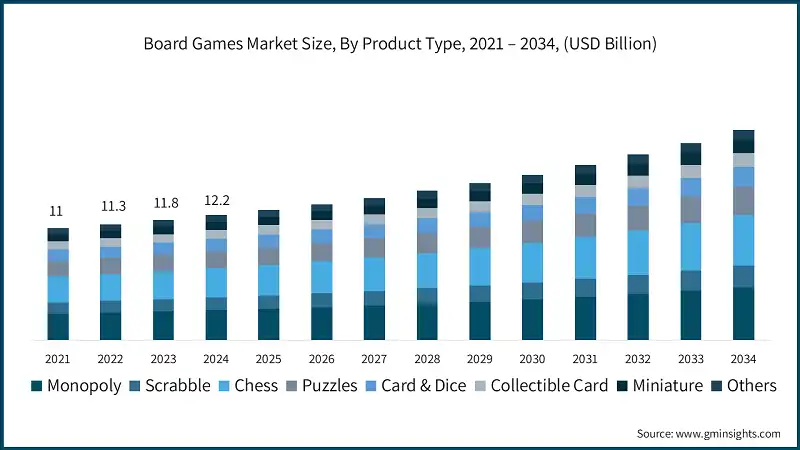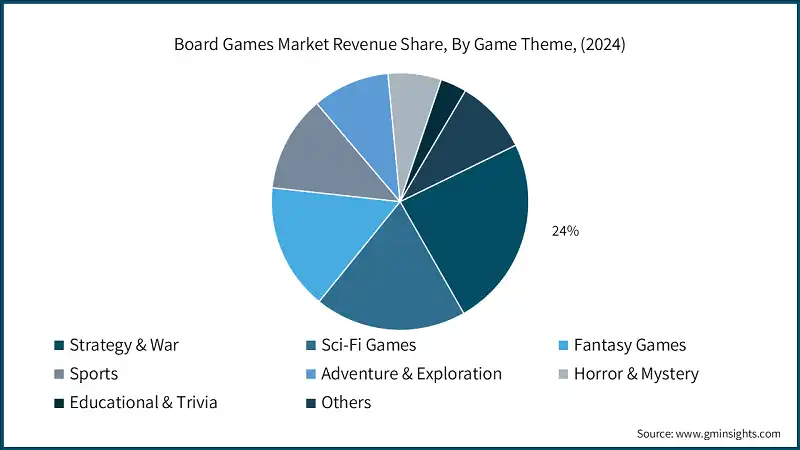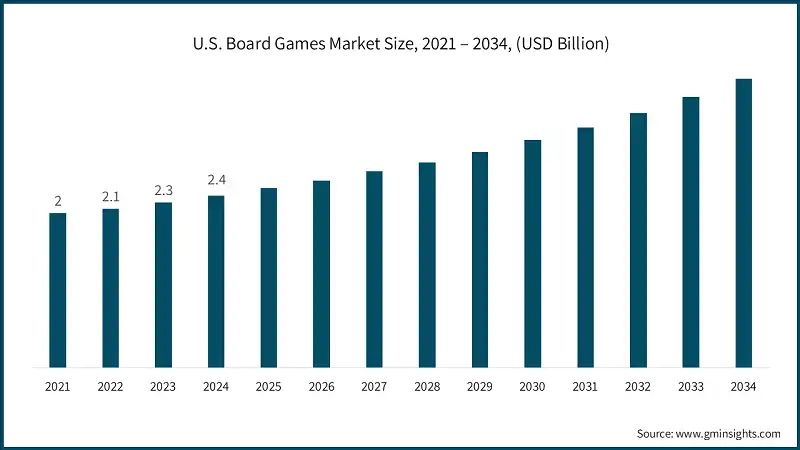Summary
Table of Content

Board Games Market
Get a free sample of this report
Thank you!
Your inquiry has been received. Our team will reach out to you with the required details via email. To ensure that you don't miss their response, kindly remember to check your spam folder as well!
Form submitted successfully!
Error submitting form. Please try again.

Request Sectional Data
Thank you!
Your inquiry has been received. Our team will reach out to you with the required details via email. To ensure that you don't miss their response, kindly remember to check your spam folder as well!
Form submitted successfully!
Error submitting form. Please try again.
Board Games Market Size
The global board games market size was estimated at USD 12.2 billion in 2024. The market is expected to grow from USD 12.8 billion in 2025 to USD 20.6 billion in 2034, at a CAGR of 5.5%, as per the latest report published by global market insights, Inc.

To get key market trends
- The arrival of crowdfunding platforms like Kickstarter and Gamefound has changed the traditional board game development and marketing landscape. These platforms let independent creators skip regular publishing hurdles, allowing them to showcase their innovative ideas directly to consumers.
- This direct-to-consumer method has opened up the industry, enabling creators to get funding from backers who connect with their concepts. This trend has resulted in a surge of niche, theme-rich, and highly creative games that meet a wide range of consumer preferences, moving the market beyond mainstream titles.
- Additionally, crowdfunding has built a sense of community among backers, who often feel personally invested in the success of the projects they support. This involvement drives initial funding and creates a loyal customer base for future releases.
- Getting direct feedback from backers during development further improves the quality and appeal of these games. As a result, the crowdfunding model has become essential for independent developers, allowing them to compete with established publishers and support the overall growth of the board game market.
- The growing presence of board game cafés, bars, and conventions has changed how consumers interact with tabletop games. These venues provide spaces where players can try new games, learn the rules in an environment, and meet other fans. According to the International Tabletop Gaming Association (ITGA), the number of board game cafés worldwide has increased by about 15% each year over the last five years, reflecting the rising interest in social and interactive gaming experiences.
- Board game cafés and events are also important marketing channels for publishers and developers. By offering a "try-before-you-buy" chance, these venues help increase sales and raise awareness of both new and existing titles.
- Furthermore, conventions like Gen Con and Essen Spiel attract tens of thousands of attendees each year, giving a platform for publishers to showcase their products to a global audience. These events create immediate sales but also serve a long-term brand awareness and customer loyalty.
Board Games Market Report Attributes
| Key Takeaway | Details |
|---|---|
| Market Size & Growth | |
| Base Year | 2024 |
| Market Size in 2024 | USD 12.2 Billion |
| Forecast Period 2025 - 2034 CAGR | 5.5% |
| Market Size in 2034 | USD 20.6 Billion |
| Key Market Trends | |
| Drivers | Impact |
| Digital integration | Digital integration modernizes traditional gameplay by adding features like tutorials, scoring automation, story narration, and immersive effects. It appeals to younger, tech-oriented audiences and reduces barriers for new players by simplifying rule explanations and setup. |
| Expansion of board game cafés and community events | Social venues like game cafés and conventions are growing worldwide. They encourage hands-on discovery and trial of new titles in casual settings. |
| Increasing crowdfunding and indie game development | Indie developers can now reach global audiences and fund niche or experimental concepts. This has fueled a surge in unique game mechanics, themes, and creative storytelling. |
| Pitfalls & Challenges | Impact |
| Digital distraction and screen-based entertainment | Consumers, especially younger ones, spend significant leisure time on digital platforms. This reduces attention spans and interest in analog, turn-based games. Board game publishers must work harder to capture interest amid competing screen-based options. |
| High manufacturing and logistics costs | Board games involve complex components such as cards, dice, miniatures, manuals often requiring overseas manufacturing. Global shipping disruptions and rising material costs impact profitability and delivery timelines. |
| Opportunities: | Impact |
| Hybrid physical-digital games | App-assisted board games blend physical gameplay with digital enhancements (e.g., sound, timers, AR). This appeals to tech-savvy players and reduces setup complexity for newcomers. |
| Educational and therapeutic applications | Board games are increasingly used in classrooms, rehab centers, and therapy sessions. They help develop cognitive, emotional, and social skills in engaging formats. |
| Market Leaders (2024) | |
| Market Leaders |
5% market share |
| Top Players |
The collective market share in 2024 is 16% |
| Competitive Edge |
|
| Regional Insights | |
| Largest market | North America |
| Fastest growing market | Asia Pacific |
| Emerging countries | Germany, UK, India, China, Brazil |
| Future outlook |
|
What are the growth opportunities in this market?
Board Games Market Trends
- Board games based on popular intellectual properties (IPs) such as movies, TV shows, and video games continue to lead the market, using their large fan bases and strong brand recognition. These games feature familiar characters and settings, making it easier for new players to learn while offering an engaging experience for fans. For example, titles like Harry Potter: Hogwarts Battle and Star Wars: Rebellion have shown that IP-driven games can attract both casual players and dedicated enthusiasts.
- The rise of board game cafés, bars, and specialty stores indicates a cultural shift toward in-person, community-driven entertainment. These venues not only serve as shops but also function as social hubs, providing rental libraries, hosting tournaments, and organizing open play events. According to the ITGA, the number of board game cafés worldwide grew by 15% annually from 2019 to 2023. Urban populations, looking for alternatives to screen-based entertainment, are increasingly attracted to these places, which encourage social interaction and deepen engagement with tabletop gaming.
- Digital platforms like YouTube and Twitch have greatly expanded the reach of board games, turning them into popular entertainment. Influencers and content creators use these platforms to play, review, and teach games, making them accessible to a wider audience. Livestreams, playthroughs, and tutorials not only make it easier for new players to join but also increase the visibility of lesser-known titles.
- Board games are increasingly combining with other media forms, such as books, comics, films, and digital games, to create richer storytelling experiences. Publishers are making games that extend or enhance existing narratives, offering players immersive transmedia experiences. For example, the board game The Witcher: Old World builds on the lore of the popular video game and book series, appealing to both collectors and fans.
- The merging of physical board games with digital platforms is speeding up, thanks to advancements in technology. Over 30% of publishers now use mobile apps, augmented reality (AR), and other digital features in their games. For instance, Hasbro's relaunch of Littlest Pet Shop on Roblox illustrates the growing trend of tech-enhanced gaming. These innovations not only improve gameplay but also attract tech-savvy young audiences, keeping the market dynamic and competitive.
Board Games Market Analysis

Learn more about the key segments shaping this market
Based on product type, the board games market can be divided into monopoly, scrabble, chess, puzzles, card & dice, collectible card, miniature, and others. The monopoly segment held the major market share, generating a revenue of USD 3 billion in 2024.
- Monopoly is one of the most globally recognized board games, renowned for its iconic design, engaging gameplay mechanics, and enduring legacy. Since its inception in 1935, Monopoly has become a staple in households worldwide, with over 275 million units sold in more than 114 countries, according to Hasbro.
- Its widespread brand recognition has cultivated a loyal consumer base and established significant trust among players. The game's straightforward rules and easy-to-understand mechanics make it accessible to a broad demographic, including children, families, and adults.
- Monopoly's unique combination of luck and strategy appeals to a wide spectrum of players, from casual participants seeking entertainment to serious gamers who enjoy strategic planning and competition. This versatility has been a key factor in its sustained popularity.
- In addition to its traditional board game format, Monopoly has successfully adapted to the digital age, further expanding its reach and relevance. The game has been transformed into video game formats and mobile applications, allowing players to enjoy the experience on various platforms. For instance, the Monopoly mobile app, developed by Marmalade Game Studio, has consistently ranked among the top board game apps on both iOS and Android platforms, reflecting its strong consumer demand.

Learn more about the key segments shaping this market
Based on game theme, the market is categorized into strategy & war, sci-fi games, fantasy games, sports, adventure & exploration, horror & mystery, educational & trivia and others. In 2024, the strategy & war segment accounted for a market share of 24% of the board games market in 2024.
- Strategy and war-themed board games have proven to be a highly engaging segment within the broader board game market. These games require players to employ advanced planning, critical thinking, and decision-making skills, which not only enhance the gaming experience but also contribute to extended play sessions and increased replay value.
- Strategy and war games are a significant driver of this growth, appealing to a niche audience that includes military history enthusiasts, tactical thinkers, and individuals who enjoy intellectually stimulating challenges. By catering to this audience, game designers can establish a loyal customer base, which is expected to propel the growth of this segment further.
- These games also foster social interaction, cooperation, and competition, making them a popular choice for group activities. They encourage players to engage in collaborative problem-solving and strategic discussions, which often lead to a sense of community and camaraderie among enthusiasts. This has resulted in the rise of organized events, tournaments, and conventions dedicated to strategy board games. For instance, Gen Con, one of the largest tabletops gaming conventions globally, reported an attendance of over 70,000 in 2023, highlighting the growing popularity of this segment.

Looking for region specific data?
In 2024, the U.S contributed significantly to the board games market growth in North America, accounting for 60.5% share in the region.
- The U.S. remains the largest and most mature board games market globally, driven by a strong consumer culture of family-oriented leisure, high disposable income, and deep-rooted nostalgia for classic titles. Major players like Hasbro and Mattel dominate the landscape, but the indie game scene has surged in recent years through crowdfunding and hobby stores. Board game cafés, conventions like Gen Con, and robust retail presence further fuel engagement.
- Beyond the U.S., Canada are showing healthy growth fueled by cross-border product availability, cultural similarities, and growing awareness of tabletop gaming as a community activity.
Asia Pacific board games market holds second largest share in 2024 and is expected to grow at 6% during the forecast period of 2025-2034.
- Asia Pacific is the fastest-growing region in the market, with rising middle-class populations, urbanization, and digital exposure fueling demand. Countries like China, Japan, South Korea, and India are witnessing a board game renaissance supported by gaming cafés, educational institutions, and youth culture. While Japan leans toward minimalistic and storytelling games, China is emerging as a manufacturing and consumer powerhouse, often combining digital and analog gaming formats.
Europe board games market is expected to grow at 5.7% during the forecast period of 2025-2034.
- Europe, especially Germany, France, and the UK, is a powerhouse of board game innovation and consumption. Germany is regarded as the home of modern Eurogames (e.g., Catan, Carcassonne), and events like Essen Spiel are globally influential. European consumers tend to favor strategic, educational, and environmentally conscious games, and sustainability in production is a rising priority.
Board Games Market Share
- The top 5 companies in the board games industry are Asmodee Group, Mattel Inc., Hasbro, Inc, Ravensburger AG, Goliath Games LLC contributing around approximately 15-20% of the market in 2024. These prominent players are proactively involved in strategic endeavors, such as mergers & acquisitions, facility expansions & collaborations, to expand their product portfolios, extend their reach to a broad customer base, and strengthen their market position.
- Asmodee Group includes internationally acclaimed titles such as Catan, Ticket to Ride, 7 Wonders, and Dobble (Spot It!). The company’s aggressive acquisition strategy has been a cornerstone of its success, enabling it to consolidate market share across diverse genres, including strategy, family, and party games. Asmodee operates in over 50 countries and has a robust distribution network, both direct and through subsidiaries, which allows it to localize content effectively and scale operations rapidly.
- Mattel Inc. includes evergreen titles like UNO, Pictionary, and Blokus, which collectively contribute to a stable revenue base. Mattel’s integration of intellectual property (IP) from its globally recognized franchises, such as Barbie and Hot Wheels, ensures its products remain relevant to evolving consumer preferences. The company’s strategic partnerships and licensing agreements have further expanded its reach, with UNO alone selling over 150 million copies worldwide as of 2023.
Board Games Market Companies
Major players operating in the board games industry include:
- Asmodee Group
- CMON Limited
- Czech Games Edition
- Days of Wonder
- Fantasy Flight Games
- Goliath Games LLC
- HABA - Habermaass GmbH
- Hasbro Inc.
- IELLO
- Indie Boards and Cards
- Kosmos Verlags-GmbH & Co. KG
- Mattel Inc.
- North Star Games
- PlayMonster LLC
- Ravensburger AG
- Schmidt Spiele GmbH
- Spin Master Corp.
- University Games Corp.
- USAopoly Inc.
- Z-Man Games LLC
Hasbro, Inc. commands a dominant position in the board game market through its extensive portfolio of legendary titles, including Monopoly, Scrabble, Clue, and Risk. The company’s ownership of major entertainment properties, such as Transformers, My Little Pony, and Dungeons & Dragons, enables it to create immersive transmedia experiences that span board games, toys, video games, and films.
Ravensburger AG is known for its emphasis on educational value and high production quality. The company’s portfolio includes popular titles such as Labyrinth, The Castles of Burgundy, and a range of Disney-themed games, which appeal to both families and hobbyists. Ravensburger’s commitment to sustainability, including its use of FSC-certified materials and eco-friendly production processes, resonates strongly with environmentally conscious consumers.
Goliath Games LLC has carved a niche in the board game market by focusing on mass-market appeal through accessible, fast paced, and often humorous games. Its portfolio includes bestsellers like Sequence, Rummikub, and Pop the Pig, which are designed to engage family and casual gamers.
Board Games Industry News
In January 2025, Z-Man announced Arkham Horror: Lovecraft Letter for a March 2025 release, signaling a return to its darker, mythos-infused storytelling roots. This move reflects the publisher’s strategic use of diverse IPs to keep the evergreen Love Letter format fresh, relevant, and engaging across both casual and hobbyist gaming segments.
- In 2024, founded by industry veterans from Z-Man Games and Stronghold Games, Play to Z made its debut with a strong focus on high-quality, strategy-driven titles. The company announced its first major project, Ascending Empires: Zenith Edition, a reimagining of the cult classic hybrid dexterity-strategy game. Launching via Kickstarter and slated for release in Q1 2024, the game reflects Play to Z’s mission to revive beloved titles with modernized mechanics and premium production.
- In May 2022, Mattel Inc., a board game and entertainment company based in the U.S., launched the Wild Twists playing card game, facilitating the entry of its flagship product, UNO cards, into a new category of gameplay and collectible cards.
The board games market research report includes in-depth coverage of the industry with estimates & forecast in terms of revenue (USD Billion) and volume (Million Units) from 2021 to 2034, for the following segments:
Market, By Product Type
- Monopoly
- Scrabble
- Chess
- Puzzles
- Card & Dice
- Collectible Card
- Miniature
- Others (Rummikub, Candy Land, Battleship)
Market, By Game Theme
- Strategy & war
- Sci-fi games
- Fantasy games
- Sports
- Adventure & exploration
- Horror & mystery
- Educational & trivia
- Others (history and civilization, etc.)
Market, By Type
- Physical
- Digital board games / mobile app adaptations
- AR/VR integrated board games
- Print and play games
Market, By Age Group
- 2 - 5 years
- 5 - 12 years
- 12 - 25 years
- Above 25 years
Market, By Distribution Channel
- Online
- E-commerce
- Company websites
- Offline
- Toy and department stores
- Specialty stores
- Supermarkets and hypermarkets
- Others (board game cafés & bars, etc.)
The above information is provided for the following regions and countries:
- North America
- U.S.
- Canada
- Europe
- Germany
- UK
- France
- Spain
- Italy
- Asia Pacific
- China
- Japan
- India
- Australia
- South Korea
- Latin America
- Brazil
- Mexico
- Argentina
- MEA
- South Africa
- Saudi Arabia
- UAE
Frequently Asked Question(FAQ) :
Who are the key players in the board games industry?
Key players include Asmodee Group, CMON Limited, Czech Games Edition, Days of Wonder, Fantasy Flight Games, Goliath Games LLC, HABA - Habermaass GmbH, Hasbro Inc., IELLO, Indie Boards and Cards.
What is the expected size of the board games market in 2025?
The market size is projected to reach USD 12.8 billion in 2025.
How much revenue did the monopoly segment generate in 2024?
The monopoly segment generated approximately USD 3 billion in 2024, dominating the market as one of the most globally recognized board games with enduring popularity.
What was the market share of the strategy & war segment in 2024?
The strategy & war segment accounted for 24% of the global board games market in 2024.
What are the upcoming trends in the board games market?
Trends include the integration of digital features like AR and mobile apps, the rise of board game cafés, and the development of transmedia storytelling experiences that enhance player engagement.
Which region leads the board games sector?
The U.S. led the North American board games market with a 60.5% share in 2024, generating significant revenue. Growth is driven by a strong consumer culture, high disposable income, and nostalgia for classic titles.
What is the projected value of the board games market by 2034?
The market is poised to reach USD 20.6 billion by 2034, fueled by technological advancements, transmedia storytelling, and growing demand for community-driven entertainment.
What is the market size of the board games in 2024?
The market size was USD 12.2 billion in 2024, with a CAGR of 5.5% expected through 2034. Growth is driven by the rise of crowdfunding platforms and increasing consumer interest in tabletop gaming.


